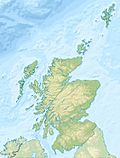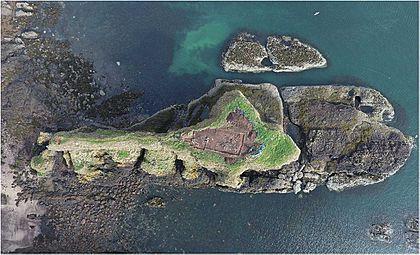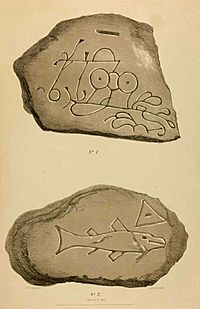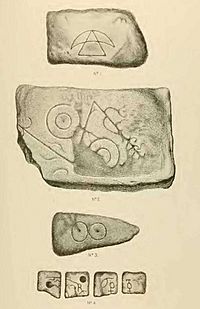Dunnicaer facts for kids
Dunnicaer, also known as Dun-na-caer, is a tall rock stack in the sea. It is located off the coast of Aberdeenshire, Scotland. You can find it between Dunnottar Castle and Stonehaven.
It's very hard to reach the top of Dunnicaer. But in 1832, special stones called Pictish symbol stones were found there. More recently, archaeologists found proof of an old Pictish hill fort. This fort might have used the stones as part of its walls. Some think the stones were carved around 300 or 400 AD. This is earlier than what most archaeologists believe for the oldest Pictish stones.
What is a Sea Stack?
Dunnicaer is a sea stack. A sea stack is a tall, narrow rock column that stands in the sea. It used to be part of the mainland cliffs. Over time, the sea eroded the softer rock around it. This left the harder rock standing alone.
Dunnicaer is in Strathlethan Bay. It's near Downie Point to the north. It's also close to the cliffs at Bowdun Head to the south. At high tide, it is completely cut off from the land.
The top of Dunnicaer is flat and grassy. It is surrounded by steep cliffs. These cliffs are about 30 to 35 meters (98 to 115 feet) high. The rock is a type of conglomerate. This rock formed a long time ago.
When the hill fort was built, Dunnicaer might have been a promontory. A promontory is a piece of land that sticks out into the sea. Over many years, the cliffs eroded. This turned the promontory into the sea stack we see today. The flat top is now about 20 by 12 meters (66 by 39 feet). This is much smaller than it was in Pictish times.
Discovering the Hill Fort
Archaeologists first explored Dunnicaer in 1977 and 1982. They didn't find anything important back then. But in 2015, a new team from Aberdeen University started digging. They began to uncover an ancient hill fort. They continued their work in the years that followed.
The fort had a stone wall. This wall was supported by wooden beams. It stretched southwest towards the mainland. Scientists used radiocarbon dating on the wood. This showed that the fort was used between the 2nd and 4th centuries AD. This makes it the oldest known Pictish fort in Scotland.
Inside the fort, they found a fireplace. They also found the foundations of rooms. Many interesting items were dug up. These included glass, special Roman pottery (called samian ware and black-burnished ware), and a lead weight. Finding these items so far north of the Roman Empire's border is very unusual.
Over hundreds of years, parts of the fort have fallen away. This happened because the cliffs around it eroded. The eastern side was especially affected.
The discoveries show that this fort was very important. It was a high-status building. The stone and oak timber used to build it came from far away. Later, the fort was left empty. Perhaps the people moved to Dunnottar Castle. Or maybe they left because the stack was eroding.
Mysterious Symbol Stones
Long ago, in 1819, a symbol stone was taken from Dunnicaer. It was used as a hearthstone. But people didn't pay much attention to its carvings.
Then, in 1832, some young people climbed to the top. They found a wall on the flat summit. They threw some of the stones into the sea. When these stones were later pulled out, they turned out to be Pictish symbol stones.
In 1857, a man named Alexander Thomson wrote about these stones. They were also drawn in books by John Stuart. These books were published in 1856 and 1867. A detailed description of the symbols was published in 1992.
Today, one of the stones is at the Marischal Museum. The others are kept at Banchory House. The design and small size of these stones are unusual. They suggest the stones are very old. They were probably set into the wall of the fort. This fort has been dated to the 3rd or 4th century AD. This is much earlier than the usual idea that the oldest Pictish stones are from the 5th or even 7th century AD.






